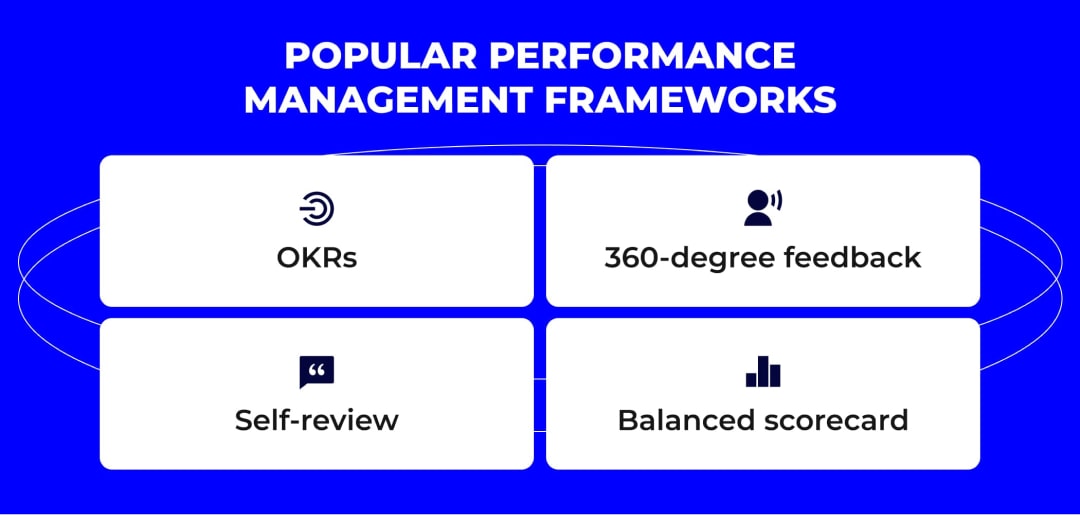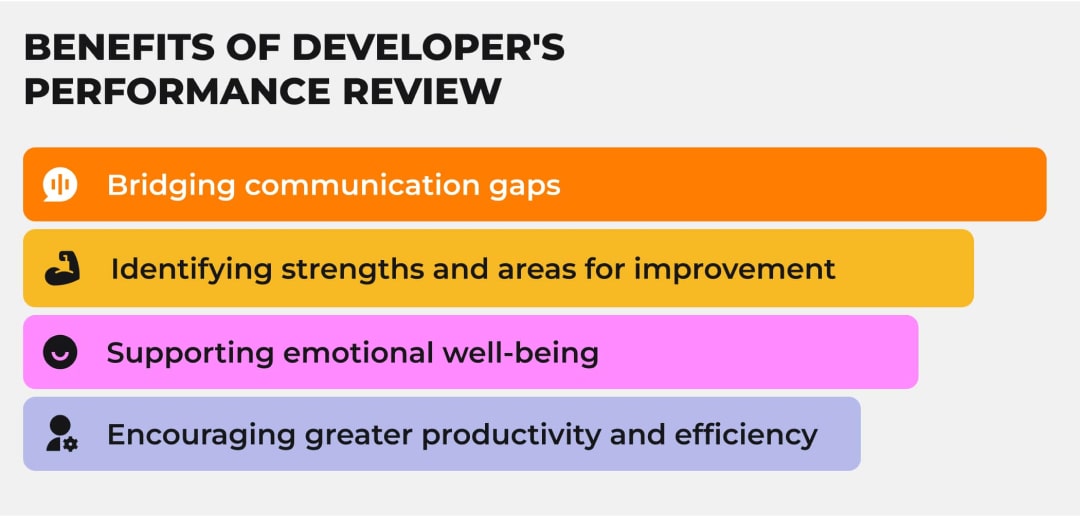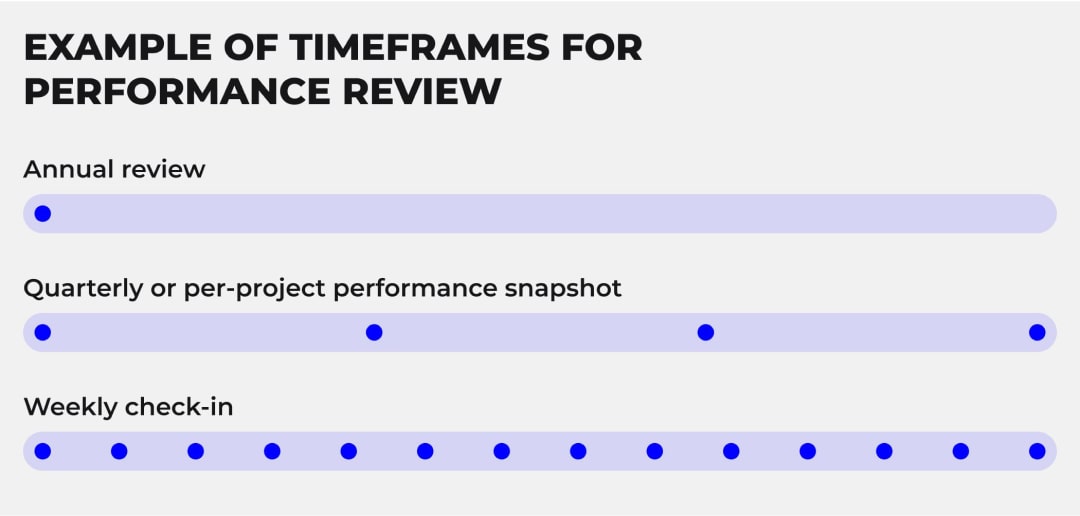Regular performance review for software developers provides a company with a window to a developer’s… code. But how to improve retention and check your tech team’s alignment with company goals? 92% of specialists want frequent and consistent feedback from their team leads. That means companies need to invest into performance management and establish a practice of fair performance reviews for software developers.
Popular Performance Management Frameworks

IT companies often use a combination of approaches and types of performance reviews to guide, assess, and improve the performance of developers. Here are the most effective ones.
OKRs
Objectives and Key Results is a successful goal-setting framework, used by most tech giants. Despite being introduced by Intel way back in the 70s, it’s still a very much applicable management tool today. OKRs are a part of the Continuous Performance Management approach. It focuses on setting specific, measurable, and time-bound goals for the team and regularly reviewing progress toward these goals.
In recent years, OKRs have been further refined by incorporating AI-powered tools to track performance. Platforms like BetterWorks or WorkBoard now enable automated progress tracking and suggest adjustments in real-time. They offer insights into productivity bottlenecks and alignment issues.
Continuous Performance Management aims to help team members to understand what is expected of them. It provides ongoing support, assisting with goals and identifying areas for improvement.
Objectives: Clear, specific, and measurable goals that an individual or a team aims to achieve. They should be aligned with the company's overall strategic goals and should be challenging yet achievable.
Key Results: The specific metrics or KPIs that will be used to measure progress and success toward the objectives. Key results should be quantifiable, data-driven, and should reflect the impact of the objectives.
Time-bound: Objectives and key results should have a specific timeframe for completion. This helps to keep the focus on delivering results in a timely manner and monitor progress.
Regular Check-Ins: Regular check-ins, typically monthly or quarterly, help to keep progress on track and provide an opportunity for feedback and course correction as needed.
Feedback and Adjustments: Feedback should be provided to the person or team based on progress toward objectives. Adjust the goals and key outcomes, if necessary, to produce results.
Used by companies: Google, Node, Spotify, Twitter, LinkedIn.
98% of specialists hired by us successfully pass performance reviews with their managers.
Hire result-driven team
360-Degree Feedback
This review method came to life long before any tech giant and even HTML or FORTRAN existed. Implemented by the military, it was an upgrade of the Multisource Feedback, which lacked an input from subordinates. 360-degree approach provides a more comprehensive view of the team member’s performance and potential.
To enhance accuracy, some organizations are integrating AI sentiment analysis into the feedback process. By analyzing textual feedback for tone and intent, these tools can identify areas of friction or support constructive suggestions that might otherwise be overlooked in subjective surveys.
Survey Instrument: A standardized survey questionnaire is used to collect feedback from various sources. The survey may include questions about specific skills, behaviors, or competencies, and may also ask for open-ended feedback.
Feedback Collection: Feedback is collected from a variety of sources, including the individual's manager, peers, subordinates, and customers. The answers should be confidential and anonymous to encourage honest and open feedback.
Feedback Report: The feedback is compiled into a report that provides a comprehensive view of the individual's strengths and areas for improvement. The report may also include graphical representations of the data. Such tools, as bar charts or radar charts help a developer understand the results.
Feedback Discussion: The team member meets with their manager to discuss the feedback and review the report. This provides an opportunity for a developer to ask questions and gain a deeper understanding of the feedback.
Development Plan: Based on the feedback, a tech specialist and their manager develop a plan for their development and growth. The plan may include specific actions, training, implementing new popular IDEs or coaching to help a team member improve in their areas of weakness.
Used by companies: 85% of Fortune 500 companies
Self-Review
The 60s were all about that personal approach. That’s exactly when self-appraisal replaced the regular performance review. A self-review allows team members to reflect on and assess their own performance. This type of evaluation can be done on a regular basis — annually or semi-annually. It helps identify areas of strength and areas for improvement.
The self-review process typically involves completing a self-assessment form. It asks the team member to rate their performance against specific job responsibilities and expectations. Referring to software engineer self evaluation examples can guide developers in structuring their reflections into relevant comments and examples.
The self-review can be a valuable tool for team members to reflect on their work, set goals for future growth, and communicate their achievements to their manager. Incorporating elements from a software engineer's guidebook, such as recommended self-assessment techniques, can further enhance this process. It can also help to increase team engagement and motivation by giving them a sense of ownership over their performance and development.
A self-review should be complemented by a developer manager’s performance review. This way, it provides a more comprehensive and objective assessment of their performance.
Balanced Scorecard
The Balanced Scorecard approach was introduced by the Harvard professors Drs. Kaplan and Norton. It became a raging success in the business management world of 1992. This approach provides a well-rounded view of the developer’s performance, including their effectiveness in managing multiple priorities. It helps to consider all relevant aspects of their role.
Perspectives: The model consists of four perspectives: financial, customer, internal processes, and learning and growth. The four perspectives provide a comprehensive view of an individual or team's performance and its impact on the overall success of the company.
Objectives and Key Results: Within each perspective, specific objectives and key results (OKRs) are established to measure progress and success. The company's entire strategy should be in line with the objectives, which should be clear, measurable, and attainable.
Performance Metrics: Specific performance metrics are established for each objective and the key result. The metrics should be quantifiable and data-driven, reflecting the impact of the objectives.
Performance Tracking: Regular tracking of performance against the objectives and key results is important to ensure progress and identify areas for improvement.
Feedback and Adjustments: Managers should provide feedback to the tech team based on performance monitoring, and adjust goals and objectives as needed to ensure success.
Used by companies: Apple, Microsoft Latin America.
Performance Review Calibration
Adjusting performance reviews helps to reduce subjectivity and bias in performance evaluations. It increases transparency and fairness, and improve the accuracy of performance assessments. This can ultimately lead to improved team performance and satisfaction.
Developer Performance Review Management Training
Companies train managers on how to effectively use performance evaluation tools. They take a step further in providing constructive feedback and setting up fair and objective evaluations.
Aligning Individual Evaluations With Organizational Goals
This involves ensuring that the evaluations of individual team members align with the overall goals and objectives of the company. Including clear performance evaluation guidelines in the employee handbook can help ensure consistency and alignment across the organization.
Conducting Calibration Sessions
In these sessions, managers come together to review and discuss their evaluations and make any necessary adjustments to ensure consistency and fairness across the organization.
Benefits of Performance Evaluation for Business

Regular performance reviews help to identify areas for improvement and provide developer feedback and coaching. This can lead to improved code quality, fewer bugs, and a better user experience for customers.
According to McKinsey & Company, well-structured performance management systems significantly enhance employee engagement and retention. A 2024 survey found that 77% of employees who received ongoing development conversations felt motivated by their company's performance management, compared to just 21% among those without.
Additionally, integrating skill-gap analysis tools into reviews ensures teams are better equipped to tackle future challenges, such as adopting new programming languages or frameworks.
Software developer performance reviews provide an opportunity for devs to discuss their goals with their manager, and to align them with the objectives of the project. This helps to ensure that developers are working towards the overall success and not planning on quitting software engineering.
Developer’s performance review provides a forum for open and honest communication between developers and their managers. This builds trust and improves the overall relationship among the team members. They become accountable for their performance and encourage them to take responsibility. This leads to increased motivation and a greater sense of ownership over their work.
Reviews also give data and insights into the strengths and weak areas of individual developers. They provide data to project planning and ensure that the right people are assigned to the right tasks. Such insights support team scaling and streamline fast hiring processes by identifying specific skill gaps that need to be filled quickly. This data will be helpful when the company considers scaling tech teams.
Performance Review for Developers Metrics
There are several metrics that can be used to evaluate the performance of a software engineer. Here are examples of performance review methodology your company can use:
Code Quality
This can be measured by using code review metrics, such as the number of code defects, the frequency of code review feedback, and the speed of code review completion.
Project Completion Rate
The software engineer's ability to complete projects on time and to meet project requirements. You can track the number of completed tasks and the percentage of projects completed on time as a part of tech team deadline management.
Customer Satisfaction
Measure the satisfaction of customers or users with the software engineer's work. You can gather customer feedback through surveys or by tracking customer support requests.
Technical Skills
The software engineer's technical knowledge and ability to apply that knowledge in their work. You can evaluate their technical skills through code review, technical assessments, and skill-building exercises.
Collaboration and Communication
The software engineer's ability to work effectively with others, including their communication skills and ability to contribute to team discussions.
Continuous Learning and Development
The developer's commitment to learning and development, including their participation in training and professional development opportunities.
Productivity
This metric measures the software engineer's output, including the number of lines of code written, the number of features implemented, and the number of bugs fixed.
Keep in mind that these metrics are just tools and should be used as part of a comprehensive performance evaluation. The most effective performance evaluations also consider qualitative factors such as the software engineer's attitude, work ethic, and ability to work well with others.
Software Engineer Performance Review Example

Subject: Performance Review for [Software Engineer Name]
Date: [Date of Review]
Objectives:
To provide feedback on [Software Engineer Name]'s performance over the past [time period]
To identify strengths and areas for improvement
To set performance goals for the upcoming [time period]
Strengths:
[Software Engineer Name] has consistently demonstrated a strong commitment to code quality, consistently producing high-quality code that meets project requirements. This serves as an excellent feedback for senior developer example in fostering best practices.
[Software Engineer Name] has consistently met project deadlines, contributing to the successful completion of multiple projects.
[Software Engineer Name] has a positive attitude and is a valuable member of the team, collaborating effectively with others and providing valuable input in team discussions.
Areas for Improvement:
[Software Engineer Name] could benefit from providing more detailed comments in their code and writing clearer documentation for users. This serves as a useful feedback for junior developer example, emphasizing the importance of foundational skills in code documentation.
[Software Engineer Name] could benefit from more actively seeking out opportunities for continuous learning and professional development.
Performance Goals:
To improve documentation skills, provide detailed comments in code and writing clearer documentation for users.
To actively seek out opportunities for continuous learning and professional development, such as attending conferences or taking online courses.
Action Plan:
[Software Engineer Name] will receive training on effective documentation practices, including code commenting and user documentation.
[Software Engineer Name] will be encouraged to attend at least one industry conference or take an online course in the next [time period].
Conclusion:
[Software Engineer Name] has been a valuable member of the team, consistently demonstrating a strong commitment to code quality and meeting project deadlines. By focusing on improving their documentation skills and actively seeking out opportunities for learning and development, [Software Engineer Name] has the potential to continue to grow and develop as a software engineer.
This, like many other software engineer performance review examples, is a common assessment of skills and overall communication. Each company can have its own metric, variations of 360-degree or software engineer peer review example.
The HR of It All
Performance reviews for software developers are an important tool for managing staff performance and growth within a company. Conducting these assessments by a tech lead with the help of a professional HR team is typically more practical. The later have the necessary expertise to ensure systematic meetings with solid frameworks, while tech leads enjoy what they love most, the tech part.
When performance appraisals are seen as tools for growth and improvement rather than judgment, employees feel more valued and motivated. It's about creating a supportive environment that fosters development and recognizes hard work.
HR teams ensure that the engineering performance review process is consistent and standardized across the team organization. Leveraging talent management services can further enhance these processes, helping to minimize possible bias and ensure that all team members are evaluated fairly and objectively.
FAQ
How to define developer productivity?
Developer productivity is defined as the measure of how efficiently a developer or a software engineering team can handle software development operations within a given time frame. This includes delivering high-quality code, meeting deadlines, and resolving issues effectively.
What is the secret to developer productivity?
The secret to developer productivity lies in boosting developer satisfaction and fostering a favorable working environment, which includes clear goals, open communication, and access to the right tools and resources.
What are the typical components of a software developer performance review?
A software developer performance review typically includes setting clear goals, gathering feedback (e.g., 360-degree or self-reviews), and assessing metrics like code quality, collaboration, and learning efforts. It also involves regular check-ins, action plans for improvement, and ensuring consistency through calibration. These components provide a holistic view of performance and growth opportunities.
Ann Kuss is the CEO at Outstaff Your Team. After 11 years of expertise in building remote tech teams for startup unicorns and global tech brands, Ann decided to lead a new venture aiming to reinvent the way international tech teams scale. Throughout her career, Ann hired specialists for countless tech positions from more than 17 countries on all major continents. Ann graduated from Kyiv-Mohyla business school, is an MIM Kyiv alumna, and regularly takes part in mentorship programs for junior tech talents. Ann actively promotes knowledge sharing and curates Outstaff Your Team blog strategy, preferring topics that solve practical needs of IT leaders. She believes that structuring business flows (including hiring) is a well-planned journey with predictable and successful outcome.




